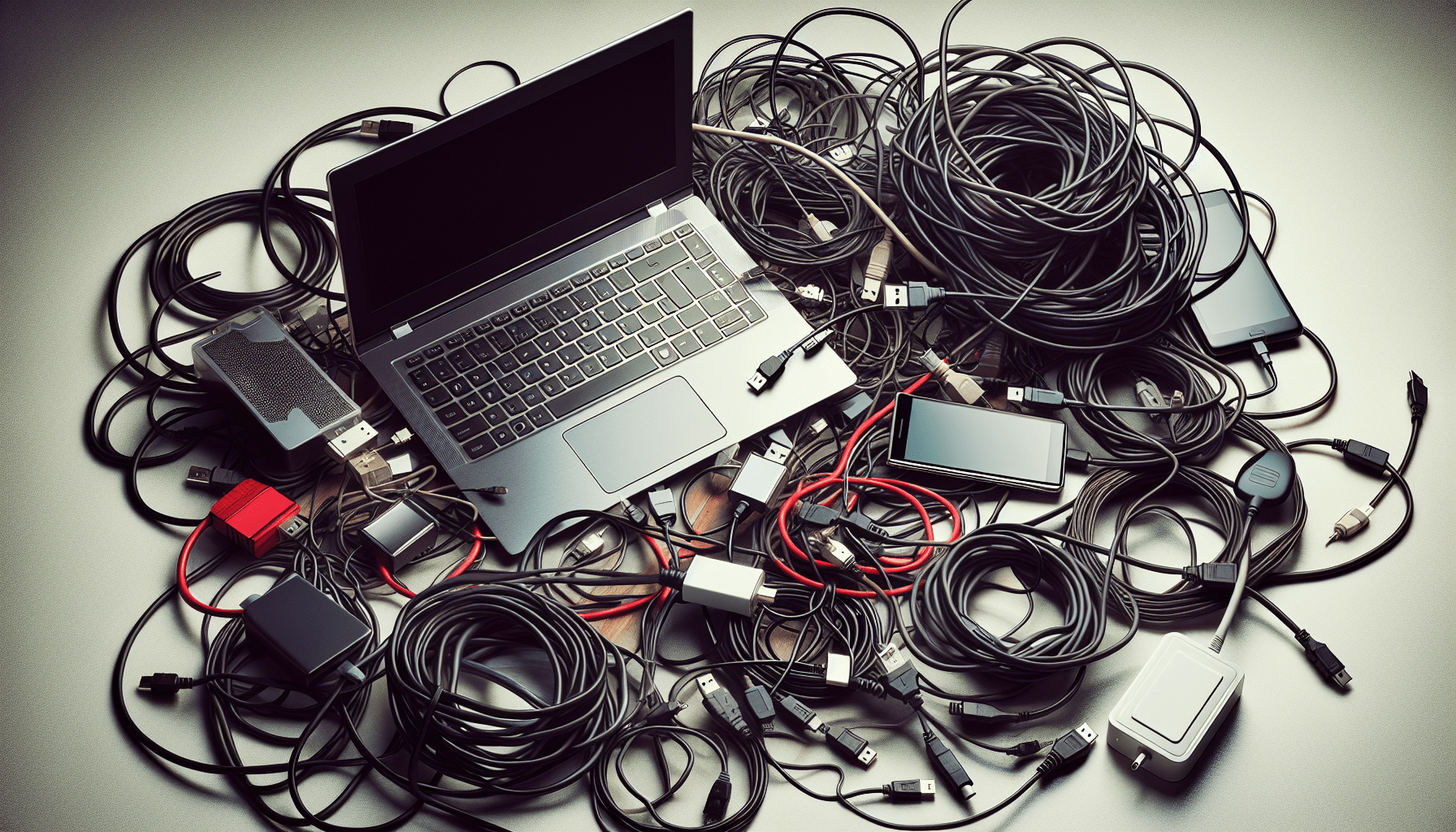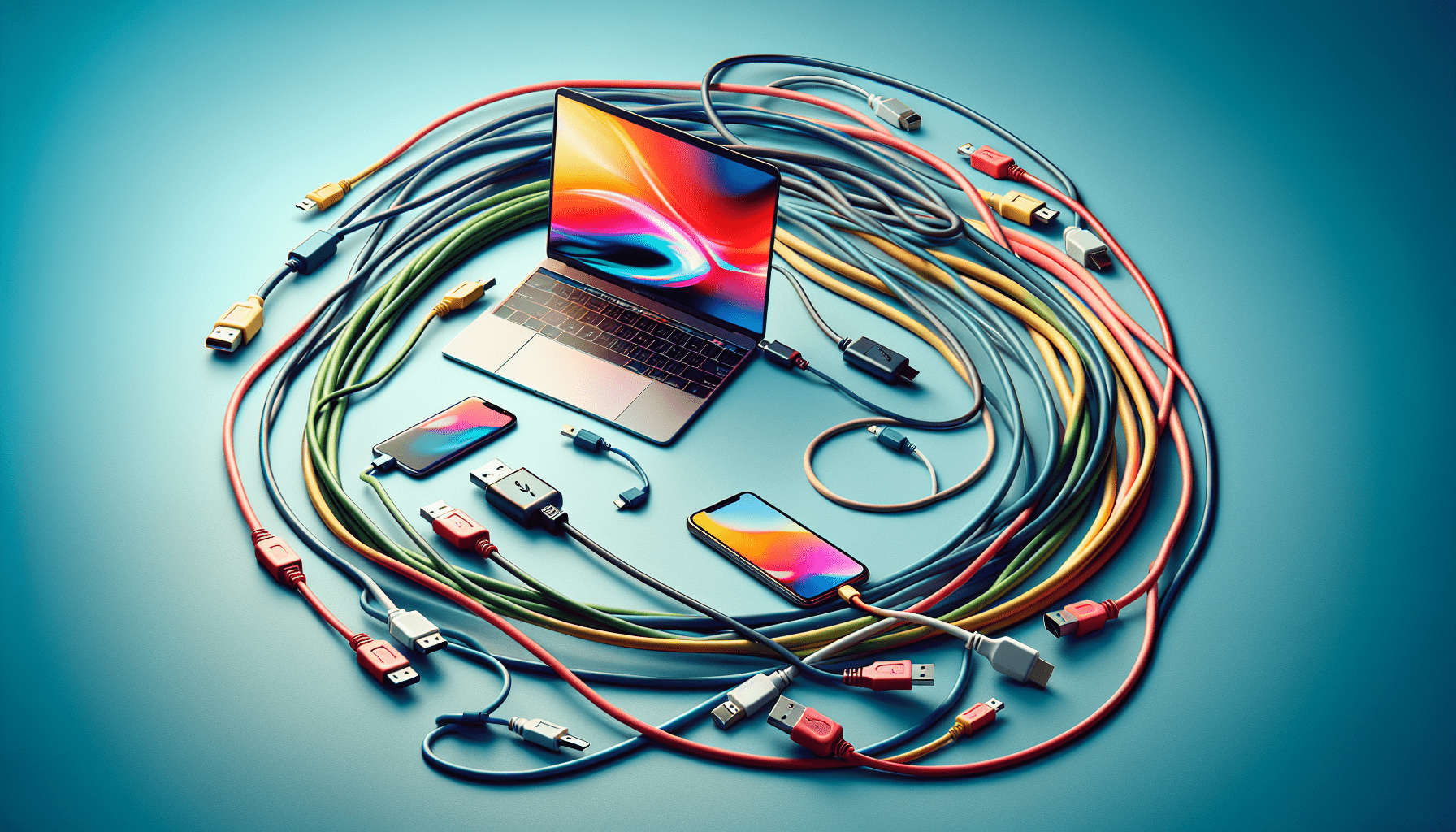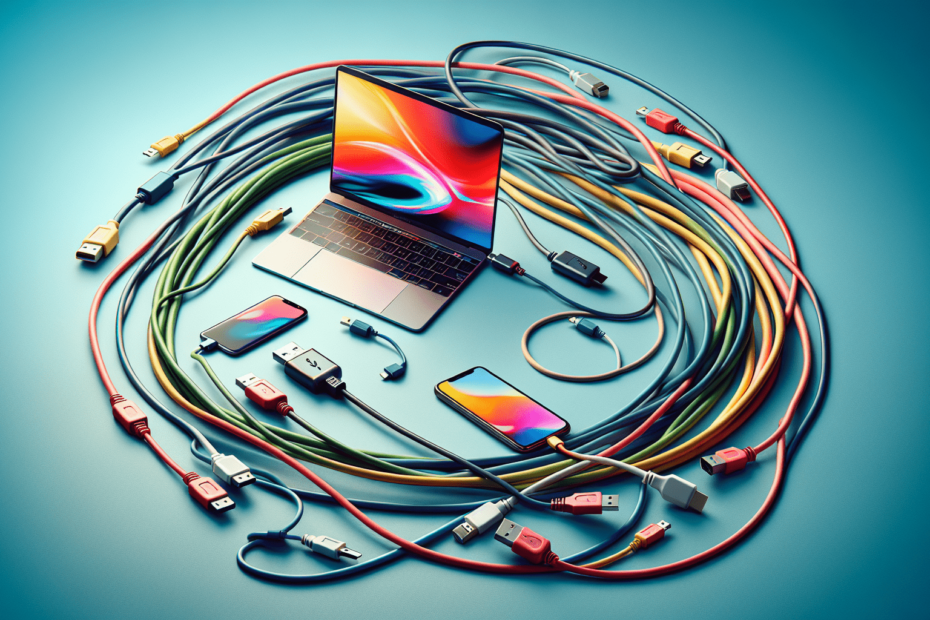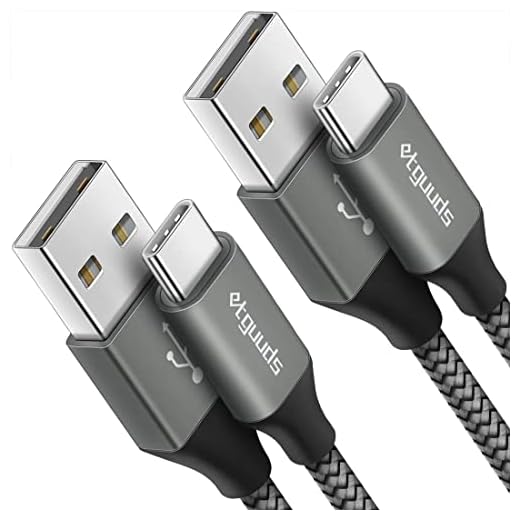







So you’ve got a new smartphone and you’re eager to sync it up with your laptop, but you’re not quite sure how to get started. Don’t worry, connecting your smartphone to your laptop is easier than you might think! In this article, we’ll walk you through the simple steps you need to take to establish a seamless connection between your devices, allowing you to effortlessly transfer files, sync apps, and much more. Whether you’re an Android or iPhone user, we’ve got you covered. Let’s get started and unlock a whole new level of convenience and efficiency in your digital life.

Wired Connection
USB Cable
One of the simplest and most common ways to connect your smartphone to your laptop is through a USB cable. Most smartphones, regardless of the brand, are equipped with a USB port that allows for data transfer. By connecting one end of the USB cable to your smartphone’s USB port and the other end to a USB port on your laptop, you can establish a wired connection and start transferring files or syncing data.
USB Type-C Connection
With the emergence of USB Type-C technology, connecting your smartphone to your laptop has become even more convenient. USB Type-C is a reversible connector that offers faster data transfer speeds and more power for charging. By using a USB Type-C cable, you can connect your smartphone to your laptop quickly and efficiently. Additionally, USB Type-C ports are becoming increasingly common on laptops, making it easier to find a compatible port for your smartphone.
Micro USB Connection
While USB Type-C has gained popularity, many smartphones still feature the older Micro USB port. If your smartphone uses a Micro USB port, you can connect it to your laptop using a Micro USB cable. Although Micro USB ports have slower data transfer speeds compared to USB Type-C, they are still widely supported by laptops and are a reliable option for connecting your smartphone.
Lightning Connection
If you are an iPhone user, you are familiar with the Lightning connector. To connect your iPhone to your laptop, you will need a Lightning cable. The Lightning cable allows you to establish a connection between your iPhone and your laptop, enabling you to transfer files or sync data. The Lightning connector is known for its fast data transfer speeds and its compatibility with various Apple devices.
Wireless Connection
Wi-Fi Hotspot
One convenient way to connect your smartphone to your laptop without any cables is by using the Wi-Fi hotspot feature on your smartphone. By turning on the Wi-Fi hotspot option on your phone, you can create a personal Wi-Fi network that your laptop can connect to. This enables your laptop to access the internet through your smartphone’s cellular data connection, providing internet connectivity without the need for a separate Wi-Fi network.
Bluetooth Connection
Another wireless option for connecting your smartphone to your laptop is through a Bluetooth connection. By pairing your smartphone and laptop via Bluetooth, you can transfer files, sync data, or even use your smartphone as a wireless keyboard or mouse for your laptop. Bluetooth technology is built into most laptops and smartphones, making it a convenient choice for establishing a wireless connection.
Near Field Communication (NFC)
If your smartphone and laptop support Near Field Communication (NFC), you can use this technology to connect the two devices. NFC allows for quick and seamless communication between devices when they are brought into close proximity. By tapping your smartphone against an NFC-enabled area on your laptop (usually indicated by an NFC logo), you can establish a connection for file transfer or data syncing.
Mobile Hotspot/Tethering
Similar to Wi-Fi hotspot, mobile hotspot or tethering features on smartphones allow you to share your cellular data connection with your laptop. By enabling the hotspot or tethering option on your smartphone, you can create a Wi-Fi network that your laptop can connect to, providing internet access. This is especially useful when you are in an area without Wi-Fi and need to connect your laptop to the internet.
File Transfer
Using USB Cable
The most straightforward and reliable method for transferring files between your smartphone and laptop is by using a USB cable. By connecting your smartphone to your laptop with a USB cable, you can establish a direct connection and transfer files quickly and securely. This method works for all types of files, including photos, videos, documents, and more. Once connected, you can simply drag and drop files between your smartphone and laptop.
Using Bluetooth
For smaller files, you can use a Bluetooth connection to transfer files wirelessly between your smartphone and laptop. This method is convenient for sending individual files or a small selection of files. However, it may not be as efficient for large file transfers due to the slower transfer speeds compared to USB or Wi-Fi.
Using Wi-Fi
If both your smartphone and laptop are connected to the same Wi-Fi network, you can transfer files wirelessly using various apps or network sharing options. By enabling file sharing on your laptop and utilizing file transfer apps or built-in file sharing features on your smartphone, you can easily send files between the two devices. This method is particularly useful for larger file transfers.
Using Cloud Storage Services
Cloud storage services like Google Drive, Dropbox, or iCloud offer a convenient way to transfer and sync files between your smartphone and laptop. By uploading files from your smartphone to the cloud storage service, you can then access those files on your laptop by logging in to the same account. This method is especially useful for syncing files across multiple devices and ensures easy access to your files from anywhere with an internet connection.
Syncing Data
Syncing Contacts
Syncing contacts between your smartphone and laptop allows you to have a unified list of contacts across both devices. This ensures that your contacts are always up to date and readily available, regardless of whether you are using your smartphone or laptop. Many email services, such as Gmail or Outlook, offer built-in contact syncing options that automatically sync contacts between your devices when you log in with the same account.
Syncing Calendar
Syncing calendars between your smartphone and laptop enables you to manage your schedule seamlessly across both devices. By syncing your calendar, you can create, edit, and view events on either your smartphone or laptop, and the changes will be reflected on both devices. Calendar syncing can be done through various email services, such as Google Calendar or Apple Calendar, or through dedicated calendar apps that support syncing.
Syncing Emails
If you use an email client or app on your smartphone and laptop, syncing your email account ensures that your emails are accessible on both devices. Whether you read, send, or delete emails on your smartphone or laptop, the changes will be synchronized across both devices. Email syncing can be configured by adding the same email account to both your smartphone and laptop email clients or apps.
Syncing Media Files
Syncing media files, such as photos, videos, or music, between your smartphone and laptop allows you to access your media library from both devices. By enabling media syncing options or using dedicated apps, you can ensure that any additions or modifications to your media library are reflected on both your smartphone and laptop. This makes it easy to enjoy your favorite media content on either device.

Screen Mirroring
Using USB Cable
To mirror your smartphone’s screen on your laptop, you can use a USB cable and software that supports screen mirroring. By connecting your smartphone to your laptop using a USB cable and installing the necessary software or drivers, you can display your smartphone’s screen on your laptop in real-time. This is especially useful for presentations, demos, or simply viewing your smartphone’s content on a larger screen.
Using Wi-Fi
Screen mirroring over Wi-Fi eliminates the need for a physical connection between your smartphone and laptop. By using dedicated screen mirroring apps or built-in screen mirroring features on your smartphone and laptop, you can mirror your smartphone’s screen wirelessly on your laptop. This allows you to navigate and control your smartphone’s screen directly from the laptop, providing a more intuitive and convenient experience.
Using Third-party Apps
Apart from USB or Wi-Fi-based solutions, there are numerous third-party apps available that facilitate screen mirroring between your smartphone and laptop. These apps often provide additional features and customization options, allowing you to optimize the screen mirroring experience based on your preferences. When using third-party apps, it is essential to ensure the security and legitimacy of the app before granting access to your smartphone and laptop.
Phone as a Remote Control
Controlling Media Playback
By connecting your smartphone to your laptop and utilizing dedicated apps or software, you can use your smartphone as a remote control for media playback on your laptop. This allows you to conveniently control media playback, such as play, pause, skip, or volume adjustments, without having to directly interact with your laptop. This feature is particularly useful for presentations, media viewing, or music playback.
Controlling Presentations
If you frequently give presentations, using your smartphone as a remote control for your laptop can enhance your presentation experience. Various apps and software solutions enable you to control your presentation slides, navigate through slides, and even highlight specific content from your smartphone. This grants you the freedom of movement during your presentation while maintaining full control over the slideshow.
Using Mobile Apps on Laptop
Emulators
Emulators are software applications that simulate the behavior of a different device or operating system on your laptop. By using emulators, you can run mobile apps designed for your smartphone on your laptop. This is especially useful if you prefer using a larger screen or if certain mobile apps are not available for your laptop’s operating system. Emulators offer an immersive experience and allow you to enjoy your favorite mobile apps on a bigger screen.
Screen Mirroring
As mentioned earlier, screen mirroring allows you to mirror your smartphone’s screen on your laptop. By utilizing screen mirroring, you can effectively use and interact with your smartphone’s apps on your laptop. This enables you to access and use mobile apps directly from your laptop, providing a more comfortable and versatile user experience.
Cloud-based Apps
Many mobile apps now offer cloud-based counterparts that can be accessed directly from a web browser on your laptop. By accessing the mobile app’s web interface, you can experience the app’s functionalities on your laptop without the need for installation. This allows you to seamlessly transition between mobile and laptop usage, ensuring consistent access to your favorite apps, regardless of the device you are using.
Charging
Using USB Cable
The most common method for charging your smartphone is through a USB cable connected to your laptop’s USB port. By connecting your smartphone to your laptop, you can charge your device while working on your laptop or even when your laptop is in sleep mode. This method eliminates the need for an additional charging adapter and ensures your smartphone stays powered throughout the day.
Using Wireless Charging
If your smartphone supports wireless charging technology, you can charge your device without any cables. Wireless charging utilizes electromagnetic fields to transfer power from a charging pad or stand to your smartphone. By placing your smartphone on a wireless charging pad or stand, you can start charging your device effortlessly. This method provides convenience and eliminates the hassle of dealing with tangled cables.
Using Docking Stations
Docking stations offer a convenient solution for charging your smartphone while providing additional functionality. These docking stations often come with built-in USB ports, wireless charging capabilities, and various connection options to your laptop. By placing your smartphone on a docking station, you can not only charge your device but also connect it to your laptop for file transfer, syncing, or screen mirroring.
Troubleshooting
Driver Issues
When connecting your smartphone to your laptop, it is possible to encounter driver issues, especially if you are using specific connection methods such as USB cable or screen mirroring. In such cases, ensure that you have the latest drivers installed on your laptop. Manufacturers often provide driver downloads on their websites, which can help resolve compatibility issues and ensure a smooth connection.
Compatibility Problems
Depending on the age, model, or operating system of your smartphone and laptop, compatibility problems may arise when attempting to connect the two devices. It is essential to check the compatibility requirements and specifications of both devices to ensure they can establish a connection. If compatibility issues persist, consider alternative connection methods or seek assistance from the device manufacturers’ support resources.
Network Connection Errors
When establishing a wireless connection between your smartphone and laptop, network connection errors may occur. These errors can be caused by various factors, such as signal interference, incorrect network settings, or software glitches. Troubleshooting network connection errors often involves resetting network settings, updating software or drivers, and ensuring a stable Wi-Fi or cellular data connection.
Security Considerations
Data Encryption
When connecting your smartphone to your laptop and transferring files or syncing data, it is crucial to prioritize data security. Utilize encryption protocols, such as secure file transfer protocols (SFTP) or virtual private networks (VPNs), to encrypt your data during transit. This ensures that your files and sensitive information remain secure and protected from unauthorized access.
Password Protection
To enhance the security of your smartphone and laptop, utilize strong, unique passwords or passphrases for both devices. By setting up password protection, you can prevent unauthorized access and secure your personal data. Additionally, consider enabling features such as biometric authentication (fingerprint or facial recognition) where available to provide an extra layer of security.
Two-Factor Authentication
Implementing two-factor authentication (2FA) on both your smartphone and laptop can significantly enhance the overall security of your devices. 2FA adds an extra step of verification, typically through a unique code sent to your smartphone, when logging in to your devices or accessing sensitive information. This ensures that even if your device’s password is compromised, an additional authentication factor is required for access.
In conclusion, connecting your smartphone to your laptop opens up a world of possibilities for file transfer, data syncing, remote control, and more. Whether through wired connections like USB or Lightning cables, wireless methods like Wi-Fi or Bluetooth, or utilizing various apps and software, you can seamlessly integrate your smartphone and laptop to enhance productivity and convenience. Just remember to consider security measures, troubleshoot any issues that may arise, and enjoy the benefits of a connected and synchronized digital ecosystem.




